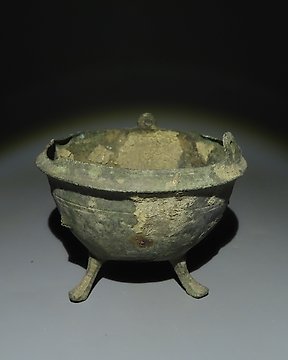
Αρχαία Ρωμαϊκή Μπρούντζος Σκάφος. 1ος-3ος αιώνας μ.Χ. Διάμετρος 8,9 cm.
Αρ. 82434381

Αρ. 82434381

Due to custom regulations we can not ship outside the E.U. Please make sure you have an EU shipping address before bidding.
Ring with a wire-wrapped Roman blue glass bead. The authentic ancient bead is set on a modern gold-plated ring.
The wire wrapping technique dates back from ca. 2000 BC and was a favourite technique of jewellery makers of ancient civilizations.
Outside diameter: ± 24 mm
Inside diameter: ± 20,7 x 15,2 mm
Diameter bead: ± 8,4 mm
Good condition and wearable. Restrung with professional new materials and new gold-plated ring. Signs of wear consistent with age and use.
Certificate of Authenticity available upon request (pdf-document).
Ancient/Roman beads:
All authentic ancient beads are slightly different in shape or colour shade and show different signs of wear or iridescence. This adds to the charm of each piece and makes every composition unique.
ANCIENT GLASS
Glass has always been found in nature, but the humans first created glass about 4.000 years ago. when ancient craftsmen in Mesopotamia discovered the art of mixing sand, soda and lime to make glass.
For centuries, glass was a luxury item and reserved for the upper classes.
Glassmaking centers around the Mediterranean world experimented with new techniques (casting, core-forming, mosaic glass) and with colours by adding metallic oxides (cobalt, copper, etc) to the mixture.
The Romans learned the glass-making craft after the conquest of Egypt in the 1st century BC. During the 1st century AD the glassblowing technique revolutionized the production and made it possible to produce larger quantities. By adding manganese dioxide Roman glassmakers successfully produced colourless or ‘aqua’ glass for the first time.
Roman glass became a very popular material, used for beads, glass windows, mosaic tiles, tableware pieces etc. Roman glass was traded all over the Roman Empire and far beyond to Central Africa, Scandinavia and via the Silk Route to China.
Πώς να πραγματοποιήσετε αγορές στην Catawiki
1. Ανακαλύψτε κάτι ιδιαίτερο
2. Υποβάλετε την κορυφαία προσφορά
3. Πληρώστε με ασφάλεια